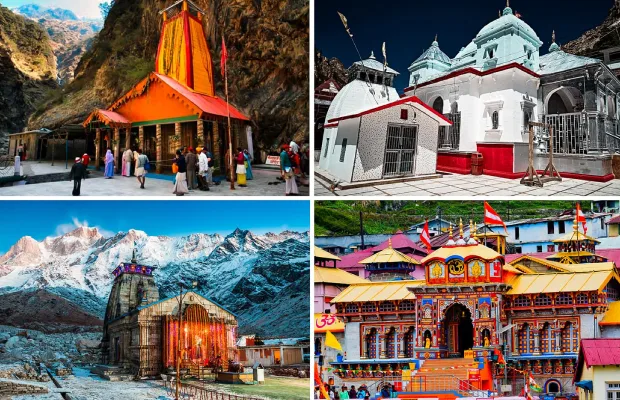
Nestled in Uttarakhand, India’s Garhwal Himalayas, is one of the holiest and unique pilgrimages in Hinduism. Hindu pilgrims traditionally strive to finish this spiritual route once in their lifetime to atone for their sins and obtain moksha or salvation. The tour covers some of the most stunning but challenging alpine country on the planet, a physical challenge and an intense act of piety. To make the journey a safe, comfortable and spiritually fulfilling experience for everyone involved, planning of routes, itinerary and preparation needs to be undertaken with serious consideration.
Char Dhams of Uttarakhand:
In Uttarakhand, the Chota Char Dham is a route that includes four separate shrines dedicated to Hindu deities, referred to as Char Dham. The traditional pilgrimage circuit covers: Kedarnath, the highest and most revered shrine devoted to Lord Shiva; Gangotri, the only source of the Ganga River; Badrinath, the residence of Lord Vishnu; and Yamunotri, the source of the Yamuna River and seat of Goddess Yamuna. The combined route is a devotional experience as each site brings a unique spiritual atmosphere as well as breathtaking views.
Traditional Char Dham Circuit:
To achieve religious benefit, the tour should be taken in a west-to-east direction, starting at Haridwar or Rishikesh and followed in the systematic sequence: Yamunotri, Gangotri, Kedarnath, Badrinath. It allows for a gentle acclimatization to height by starting off with the lower temples and gradually ascending to the larger ones. Barkot, Uttarkashi, Guptkashi/Sitapur, and Badrinath are the major route towns. Road segments and trekking sections should be well-planned since the whole route is made up of motorable roads with prominent treks.
What should be the ideal travel duration for the Char Dham yatra?
From and to Haridwar or Delhi, a typical and recommended Char Dham yatra trip requires a minimum of 10 to 12 days. The duration takes for the gruelling treks to Yamunotri and Kedarnath, the rest and acclimatization days required and the long driving hours per day necessary to cover the long distances between the base camps are all factored into this period. Make safe completion of the entire spiritual route, two buffer days are highly suggested to be planned to cover unexpected delays due to untimely weather, landslides or roadblocks in the Himalayas.
Best Time to Book Char Dham Yatra:
The ideal time to book the Char Dham Yatra is during late April, early May, to October, early November, when the Char Dham temples are accessible for roughly half the year. They remain closed during the winter season when snowfall is heavy. The two best windows of May to mid-June and September to October are the best periods to plan the yatra. May and June, before the monsoon, have pleasant, comparatively warm weather. Once the rains have set in, September and October provide clear sky, excellent visibility and crisp, cool air, making driving easier and the sight of Himalayan peaks inspiring.
Trekking and accessibility on this route:
However, most of the tour can be driven; two shrines require a lot of struggles in terms of physical exertion. The 6 km trek from Janki Chatti is the final ascent to Yamunotri. The toughest is Kedarnath, 18 kms away from Gaurikund and takes a full day to reach. Strong physical fitness and preparation for the long ascent and descent days are essential because private vehicles can only reach designated parking areas, after which devotees must rely on shared taxis, ponies or a helicopter for the final stretch to the trekking start point.
Food and accommodation:
In the larger base towns like Uttarkashi, Guptkashi and Badrinath, accommodation facilities on the Char Dham route vary from cheap hotels to basic dharamshalas and guest houses. Accommodation near the temples, especially Kedarnath, is usually basic and functional. Maintain the purity of the pilgrimage; all food is served vegetarian. Avoid last-minute problems and high expenses in remote regions; all accommodations must be reserved well ahead of time because of peak season demand, particularly if travelling in a group on a Tempo Traveller.
Travel tips for Char dham yatra:
A convenient pilgrimage can be guaranteed by paying attention to some useful tips. Carry enough warm clothes with you, including rainwear, woollens and thermal wear, as even in summer, mountain weather may drastically change. Next, before undertaking the journey, ensure you do the necessary Char Dham Registration, authenticated multiple times. Carry sufficient cash because not many small-sized enterprises accept electronic purchases, and there are often dodgy ATMs in rural areas. Maintain silence in temple complexes and ensure all bookings are confirmed before leaving the plains.
Conclusion –
The Char Dham Yatra package offers a deep faith and a struggle for personal transformation. Careful planning, following the conventional route sequence and choosing the best time would be a prerequisite for a smooth finish. The pilgrims can reduce hazards associated with mountain travel by obtaining all necessary paperwork, reservations for lodging well in advance. This thorough planning ensures that the pilgrimage will be treasured as and divine memory, keeping attention on the spiritual importance of witnessing Yamunotri, Kedarnath, and Badrinath.